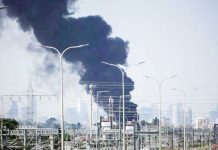ILOILO – Dengue cases in this province have surged past 2,000, with the provincial health office confirming 10 deaths as of June 7 — a 75 percent increase from the same period last year.
Data from the Iloilo Provincial Health Office (IPHO) revealed that from January 1 to June 7, a total of 2,051 dengue cases were recorded, up from 1,175 in 2023.
The death toll has also doubled, with the latest fatality being a 35-year-old woman from Lambunao town who died on June 1.
Dr. Rodney Labis of IPHO’s Health Service Delivery Division, however, emphasized that while the overall case count remains high, the trend has begun to decline slightly in the past two weeks, with a 14 percent drop in new cases — down to 157 from 182 previously.
The municipalities with the most reported cases are San Joaquin (163), Oton (118, with one death), Leon (102), Cabatuan (101), Dumangas (101), Pototan (81, with two deaths), Lambunao (75, with one death), San Dionisio (68), Janiuay (65), and Calinog (64).
Dengue is a potentially fatal viral infection transmitted by the bite of an infected Aedes aegypti and Aedes albopictus day-biting mosquito. Symptoms include high fever, severe headache, muscle and joint pain, skin rashes, and in severe cases, internal bleeding. There is no specific cure for dengue, and early medical intervention is key to avoiding complications.
Other areas also reported significant numbers, including Sara (63 cases with one death), Ajuy (62), Pavia (59), Passi City (56), Maasin (53), Barotac Nuevo (46), Concepcion (46), Banate (45), Santa Barbara (44), Barotac Viejo (43), Estancia (43), Tigbauan (41 cases with one death), Carles (40 cases with two deaths), Miag-ao (37), San Miguel (37), San Rafael (32), Alimodian (28), Batad (28), Anilao (27), Guimbal (27), Badiangan (25), Dingle (25), Dueñas (25 cases with one death), Balasan (23 cases with one death), Mina (23), Lemery (21), Zarraga (21), Igbaras (19), Bingawan (17), Leganes (17), Tubungan (17), San Enrique (16), and New Lucena (seven).
Eleven municipalities were also identified with case clustering — or at least three dengue cases in a barangay within a four-week span. These include areas in Cabatuan (Barangay Banguit, three cases); Carles (Barangay Nalumsan, three cases); Concepcion (Barangay Igbon, three cases); Dumangas (Barangay Bolilao, three cases; and Barangay Talusan, three cases); Leon (Barangay Tacuyong Norte, three cases); Oton (Barangay Ilaud, five cases); Pototan (barangays Cansilayan, three cases; Igang, three cases; and Guibuangan, five cases); San Joaquin (barangays Purok 5, three cases; Santa Rita, three cases; and Lawigan, five cases); Santa Barbara (Barangay Balibagan Oeste, three cases); Sara (Barangay Pasig, three cases); and Zarraga (Barangay Ilawod PoblacIon, three cases).
Children and teenagers remain the most vulnerable. Of the total cases:
* 844 were aged 10–19 years
* 675 were 1–9 years old
* 304 were 20–29 years old
* 309 were 40 years and above
* 125 were 30–39 years old
* 63 were under one year old
IPHO chief Dr. Maria Socorro Colmenares-Quiñon urged the public — especially parents — to seek early medical consultation if dengue symptoms appear in their children. She also reinforced the 4S strategy for prevention:
1. Search and destroy mosquito-breeding sites;
2. Secure self-protection with repellents and protective clothing;
3. Seek early consultation for fever and symptoms; and
4. Support fogging in high-case areas.
The provincial government continues its monitoring and prevention campaign amid the ongoing rainy season, a period known for heightened mosquito activity./PN





